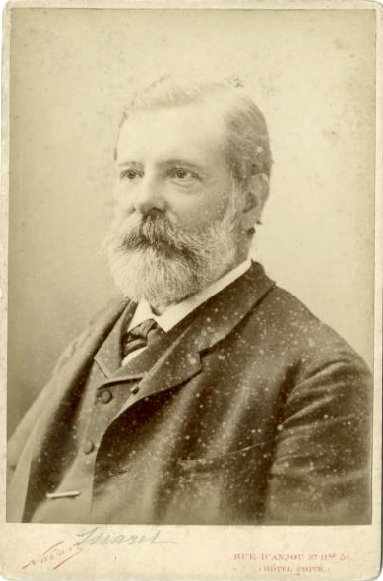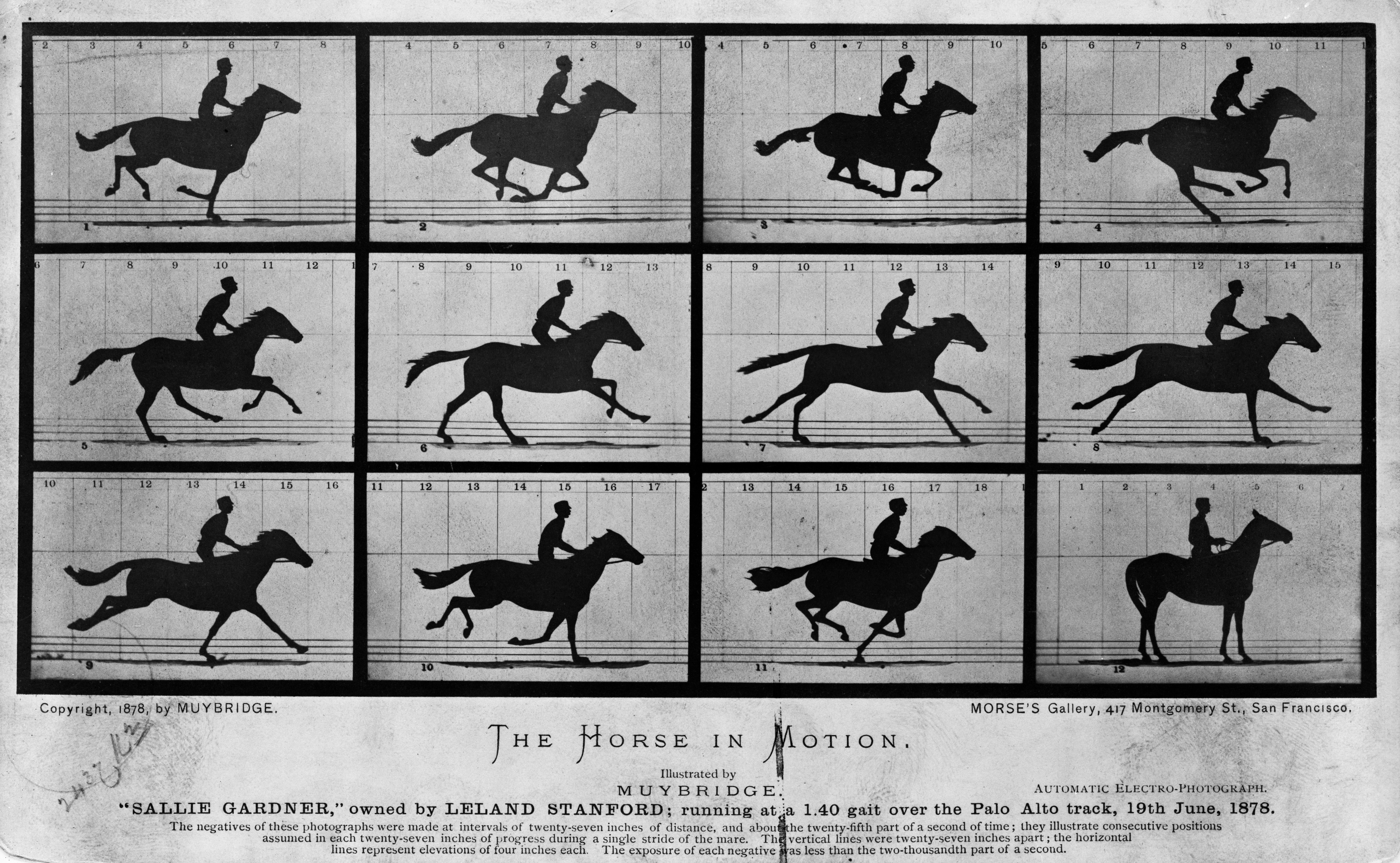|
Chronophotographic Gun
The chronophotographic gun is one of the ancestors of the movie camera. It was invented in 1882 by Étienne-Jules Marey, a French scientist and chronophotographer. It could shoot 12 images per second and it was the first invention to capture moving images on the same chronomatographic plate using a metal shutter. History Étienne-Jules Marey invented it in 1882, based on the photo revolver invented in 1874 by the French astronomer Jules Janssen. Janssen invented it because he wanted to study the different phases of the sun and the movements of Venus. Marey, on the other hand, wanted to study how animals, insects and birds moved. He tried to use the chronophotographic gun to study bigger animals like horses or people, but the images superimposed on the film. Due to the slowness of the bigger animals there was no time between photo and photo for the subject to move sufficiently from the last position and it appeared all together and superimposed. Functioning The functioning o ... [...More Info...] [...Related Items...] OR: [Wikipedia] [Google] [Baidu] |
Fusil Photographique Marey2
Fusil may refer to: *Fusil, a light flintlock musket used by a fusilier *Fusil (heraldry) The lozenge in heraldry is a diamond-shaped rhombus charge (an object that can be placed on the field of the shield), usually somewhat narrower than it is tall. It is to be distinguished in modern heraldry from the fusil, which is like the loze ..., a heraldic ordinary similar to a lozenge * Gerald Fusil, creator of the Raid Gauloises adventure race {{disambig ... [...More Info...] [...Related Items...] OR: [Wikipedia] [Google] [Baidu] |
Movie Camera
A movie camera (also known as a film camera and cine-camera) is a type of photographic camera that rapidly takes a sequence of photographs, either on an image sensor or onto film stock, in order to produce a moving image to project onto a movie screen. In contrast to the still camera, which captures a single image at a time, by way of an intermittent mechanism, the movie camera takes a series of images; each image is a ''frame'' of film. The strips of frames are projected through a movie projector at a specific frame rate (number of frames per second) to show a moving picture. When projected at a given frame rate, the persistence of vision allows the eyes and brain of the viewer to merge the separate frames into a continuous moving picture. History An interesting forerunner to the movie camera was the machine invented by Francis Ronalds at the Kew Observatory in 1845. A photosensitive surface was drawn slowly past the aperture diaphragm of the camera by a clockwork mechanism to ... [...More Info...] [...Related Items...] OR: [Wikipedia] [Google] [Baidu] |
Étienne-Jules Marey
Étienne-Jules Marey (; 5 March 1830, Beaune, Côte-d'Or – 15 May 1904, Paris) was a French scientist, physiologist and chronophotographer. His work was significant in the development of cardiology, physical instrumentation, aviation, cinematography and the science of laboratory photography. He is widely considered to be a pioneer of photography and an influential pioneer of the history of cinema. He was also a pioneer in establishing a variety of graphical techniques for the display and interpretation of quantitative data from physiological measurement. Biography Marey started by studying Circulatory system, blood circulation in the human body. Then he shifted to analyzing heart beats, respiration, muscles (myography), and movement of the body. To aid his studies he developed many instruments for precise measurements. For example, in 1859, in collaboration with the physiologist Auguste Chauveau and the watch manufacturer Breguet (brand), Breguet, he developed a wearable ' ... [...More Info...] [...Related Items...] OR: [Wikipedia] [Google] [Baidu] |
Janssen Revolver
The Janssen revolver (french: revolver photographique) was invented by the French astronomer Pierre Jules César Janssen in 1874. It was the instrument that originated chronophotography, a branch of photography based on capturing movement from a sequence of images. To create the apparatus Pierre Janssen was inspired by the revolving cylinder of Samuel Colt's revolver. Usage The revolver used two discs and a sensitive plate, the first with twelve holes ( shutter) and the second with only one, on the plate. The first one would take a full turn every eighteen seconds, so that each time a shutter window passed in front of the window of the second (fixed) disk, the sensitive plate was discovered in the corresponding portion of its surface, creating an image. In order for the images not to overlap, the sensitive plate rotated with a quarter of the shutter speed. The Shutter Speed was one and a half seconds. A mirror on the outside of the apparatus reflected the movement of the obje ... [...More Info...] [...Related Items...] OR: [Wikipedia] [Google] [Baidu] |
Shutter Speed
In photography, shutter speed or exposure time is the length of time that the film or digital sensor inside the camera is exposed to light (that is, when the camera's shutter (photography), shutter is open) when taking a photograph. The amount of light that reaches the Photographic film, film or image sensor is proportional to the exposure time. of a second will let half as much light in as . Introduction The camera's shutter speed, the lens's aperture or f-stop, and the scene's luminance together determine the amount of light that reaches the film or sensor (the exposure (photography), exposure). Exposure value (EV) is a quantity that accounts for the shutter speed and the f-number. Once the sensitivity to light of the recording surface (either film or sensor) is set in numbers expressed in "Film speed#ISO, ISOs" (ex: 200 ISO, 400 ISO), the light emitted by the scene photographed can be controlled through aperture and shutter-speed to match the film or sensor sensitivity ... [...More Info...] [...Related Items...] OR: [Wikipedia] [Google] [Baidu] |
Silver Bromide
Silver bromide (AgBr) is a soft, pale-yellow, water-insoluble salt well known (along with other silver halides) for its unusual sensitivity to light. This property has allowed silver halides to become the basis of modern photographic materials. AgBr is widely used in photographic films and is believed by some to have been used for making the Shroud of Turin. The salt can be found naturally as the mineral bromargyrite. Preparation Although the compound can be found in mineral form, AgBr is typically prepared by the reaction of silver nitrate with an alkali bromide, typically potassium bromide: :AgNO3(aq) + KBr(aq) → AgBr(s)+ KNO3(aq) Although less convenient, the compound can also be prepared directly from its elements. Modern preparation of a simple, light-sensitive surface involves forming an emulsion of silver halide crystals in a gelatine, which is then coated onto a film or other support. The crystals are formed by precipitation in a controlled environment to produce smal ... [...More Info...] [...Related Items...] OR: [Wikipedia] [Google] [Baidu] |
Chronophotography
Chronophotography is a photographic technique from the Victorian era which captures a number of phases of movements. The best known chronophotography works were mostly intended for the scientific study of locomotion, to discover practical information for animal handlers and/or as reference material for artists. Although many results were not intended to be exhibited as moving pictures, there is much overlap with the more or less simultaneous quest to register and exhibit photographic motion pictures. Definition Chronophotography is defined as "a set of photographs of a moving object, taken for the purpose of recording and exhibiting successive phases of motion". The term ''chronophotography'' was coined by French physiologist Étienne-Jules Marey to describe photographs of movement from which measurements could be taken and motion could be studied. It is derived from the Greek word χρόνος '' chrónos'' ("time") combined with ''photography''.The J. Paul Getty Museum (1990). ... [...More Info...] [...Related Items...] OR: [Wikipedia] [Google] [Baidu] |
Eadweard Muybridge
Eadweard Muybridge (; 9 April 1830 – 8 May 1904, born Edward James Muggeridge) was an English photographer known for his pioneering work in photographic studies of motion, and early work in motion-picture projection. He adopted the first name "Eadweard" as the original Anglo-Saxon form of "Edward", and the surname "Muybridge", believing it to be similarly archaic. Born in Kingston upon Thames, England, at the age of 20 he emigrated to the United States as a bookseller, first to New York City, and eventually to San Francisco. In 1860, he planned a return trip to Europe, and suffered serious head injuries in a stagecoach crash in Texas en route. He spent the next few years recuperating in Kingston upon Thames, where he took up professional photography, learned the wet-plate collodion process, and secured at least two British patents for his inventions. He returned to San Francisco in 1867, a man with a markedly changed personality. In 1868, he exhibited large photographs o ... [...More Info...] [...Related Items...] OR: [Wikipedia] [Google] [Baidu] |
Leland Stanford
Amasa Leland Stanford (March 9, 1824June 21, 1893) was an American industrialist and politician. A member of the Republican Party, he served as the 8th governor of California from 1862 to 1863 and represented California in the United States Senate from 1885 until his death in 1893. He and his wife Jane were also the founders of Stanford University, which they named after their late son. Prior to his political career, Stanford was a successful merchant and wholesaler who built his business empire after migrating to California during the Gold Rush. As president of the Central Pacific Railroad and later the Southern Pacific from 1885 to 1890, he held tremendous power in the region and a lasting impact on California. Early life and career Leland Stanford was born in 1824 in what was then Watervliet, New York (now the Town of Colonie). He was one of eight children of Josiah and Elizabeth Phillips Stanford. Among his siblings were New York State Senator Charles Stanford (1819– ... [...More Info...] [...Related Items...] OR: [Wikipedia] [Google] [Baidu] |
The Horse In Motion
''The Horse in Motion'' is a series of cabinet cards by Eadweard Muybridge, including six cards that each show a sequential series of six to twelve "automatic electro-photographs" depicting the movement of a horse. Muybridge shot the photographs in June 1878. An additional card reprinted the single image of the horse "Occident" trotting at high speed, which had previously been published by Muybridge in 1877. The series became the first example of chronophotography, an early method to photography, photographically record the passing of time, mainly used to document the different phases of locomotion for scientific study. It formed an important step in the development of Film, motion pictures for years to come. Muybridge's work was commissioned by Leland Stanford, the industrialist, former Governor of California, and horseman, who was interested in horse gait analysis. in 1882, Stanford had a book published about the project, also entitled ''The Horse in Motion'', with circa ... [...More Info...] [...Related Items...] OR: [Wikipedia] [Google] [Baidu] |
Auguste And Louis Lumière
The Lumière brothers (, ; ), Auguste Marie Louis Nicolas Lumière (19 October 1862 – 10 April 1954) and Louis Jean Lumière (5 October 1864 – 6 June 1948), were French manufacturers of photography equipment, best known for their ''Cinématographe'' motion picture system and the short films they produced between 1895 and 1905, which places them among the earliest filmmakers. Their screening of a single film on 22 March 1895 for around 200 members of the "Society for the Development of the National Industry" in Paris was probably the first presentation of projected film. Their first commercial public screening on 28 December 1895 for around 40 paying visitors and invited relations has traditionally been regarded as the birth of cinema. Either the techniques or the business models of earlier filmmakers proved to be less viable than the breakthrough presentations of the Lumières. History The Lumière brothers were born in Besançon, France, to Charles-Antoine Lumière (1 ... [...More Info...] [...Related Items...] OR: [Wikipedia] [Google] [Baidu] |





.jpg)



